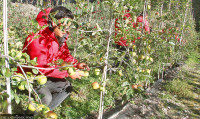National
Supreme Court on trial as it’s justices vs chief justice
With Chief Justice Rana refusing to budge, judges wonder how long they can deprive the public of their right to justice, as the crisis in the judiciary deepens.
Tika R Pradhan
It has been more than two weeks that Supreme Court justices have not heard any cases except for habeas corpus. With 19 justices standing against Chief Justice Cholendra Shumsher Rana demanding that the latter step down, the crisis in the judiciary has deepened.
Supreme Court justices have not officially declared that they would not hear other cases, but for over the last two weeks they have been “holding meetings”. As a result, hearings have been affected. Despite calls from the justices, Nepal Bar Association and the Supreme Court Bar Association, Chief Justice Rana has refused to step down.
According to Baburam Dahal, spokesperson for the Supreme Court, currently there are 28,966 cases awaiting hearings.
The crisis in the judiciary now is affecting service seekers. But there is no solution in sight.
Even justices at the Supreme Court admit that the situation is too difficult to handle. While they want Rana to resign, they cannot avoid benches for long, as such a move would raise a moral question for them.
At least 11 working days—if festival holidays are not counted—have been affected ever since justices started “avoiding” benches on October 24.
Until Monday, around a dozen habeas corpus petitions have been heard.
“For the general public, it does not matter whether there is a problem in the judiciary… members of the public know one fact—that the judiciary must keep delivering justice,” said Anup Raj Sharma, a former chief justice. “People’s rights to justice cannot be curtailed on any pretext. Supreme Court justices want reforms in the judiciary. But they need to find a way to do so without depriving people of their right to justice.”
Chief Justice Rana faces a slew of allegations, including trying to trample upon the principle of separation of powers.
Despite calls from justices and several quarters, Rana has refused to resign, arguing that a chief justice can be removed only through the provisions laid down in the constitution.
The post of chief justice becomes vacant only when he or she dies, resigns or he or she is impeached. To impeach a chief justice, political parties need to file a motion in Parliament, but none of the parties so far has made any move.
“The justices have made their point clear that the judiciary is in need of reforms. They have also made it clear that the first step should be the resignation of the chief justice,” said Sharma. “If our justices continue to not hear cases, questions could arise that they are no different from the chief justice.”
It has become apparent that the crisis the judiciary is facing is an outcome of over-politicisation. Nepal’s political parties have long been interfering in the judiciary—so much so that justices are appointed under “political quotas”.
While justices are under pressure now—as they cannot continue to boycott benches for long—political parties have maintained an uncanny silence on the ongoing crisis.
A Supreme Court justice, who did not wish to be named, said that judges are facing a tough time, as they can neither backtrack on their demand for Rana’s resignation nor continue to avoid benches.
“We are not in a comfortable situation,” said the justice. “We are firm on our position that the chief justice should step down… but if he does not, how long can we refuse to hear people's cases.”
Many say the silence of political parties, which are the main cause of most of the ills in the judiciary, is surprising. Supreme Court justices too want political parties to take initiatives to find a way out of the current crisis in the judiciary.
Rana will be relieved of his duties as soon as an impeachment motion is registered. One fourth of the members of Parliament can register such a motion. But the parties in the ruling coalition lack the numbers independently. The main opposition, CPN-UML, has the numbers, but it does not seem keen on filing an impeachment motion against Rana.
“Since the chief justice has refused to step down, the only option left is an impeachment motion which should be initiated by parliamentarians,” said Prakash Osti, a former Supreme Court justice. “Political parties must speak up.”
But unless the parties make a move, justices need to find a way out.
Some from the legal fraternity, including former judges, have already started questioning the Supreme Court justices for not hearing the cases in their revolt against the chief justice.
“The primary duty of the justices is to deliver justice to the people. They can continue their fight against the chief justice, but how can they, who survive on taxpayers’ money, deprive the public of justice,” said Krishna Jung Rayamajhi, a former justice of the Supreme Court. “Nepal’s judiciary has problems and these problems need to be addressed. But at what cost? At the cost of people’s right to justice?”
On Monday as well Supreme Court justices held a meeting to discuss the current crisis in the Supreme Court.
“We are indeed concerned about the public’s right to justice which is a very serious matter,” a justice who attended the meeting told the Post. “We have been trying to find a way. We want to ensure that the judiciary sees reforms just as the public continues to get justice.”
According to the justice, who did not wish to be named, the judges have been hearing habeas corpus petitions only but they will have to think if the chief justice starts assigning other cases.
“We cannot compromise on the people’s right to justice and we are well aware of this fact,” said the justice. “But we are also equally concerned about the anomalies in the judiciary which we need to address and reforms can start only after the chief justice resigns.”
When questions were raised against Rana, especially after it was reported that he sought a share in the Cabinet, Supreme Court justices reacted quickly to demand his resignation. The Nepal Bar Association and the Supreme Court Bar Association too made Rana’s resignation their bottom line.
While the bar associations can protest in their own ways, justices have to be careful while taking decisions, according to legal experts and former justices.
“The justices are now in trouble because they thought Rana would resign as soon as demands for him to step down grew,” said Sharma, the former chief justice. “But since Rana refused to resign, the justices are in a fix.”
The Nepal Bar Association, which has been demanding Rana’s resignation for the last two weeks, on Monday announced its second phase of protests, beginning from Tuesday.
According to Rakshya Basyal, vice-chair of the Nepal Bar, the association has decided to continue its protests until the chief justice steps down. Nepal Bar has also demanded that the chief justice should not allocate benches for him.
It is yet to be seen whether the chief justice allocates benches for him or not.
On Monday, the first day of office after Tihar holidays, Rana allocated six benches–four division benches and two single benches–for nine justices including himself.
Rana allocated four division benches of himself and Kumar Chudal; Bishwombhar Prasad Shrestha and Manoj Kumar Sharma; Prakash Kumar Dhungana and Kumar Regmi; and two single benches of Kumar Chudal and Bam Kumar Shrestha.
All five benches except the division bench in which Rana was present with Kumar Chudal heard one each habeas corpus petitions on Monday.
Sources close to Rana said he is considering allocating all kinds of cases for justices from Tuesday, citing the problems justice seekers were facing.
Balaram KC, a former Supreme Court justice, said since Rana has come under pressure, he is trying to bide time.
“It is understandable that justices are facing a moral question. But what they can do is isolate the chief justice,” said KC. “The justices while should hear cases, they should avoid benches where the chief justice is involved. There is a need to make people… the public understand that the chief justice is the source of the ills in the judiciary.”




 6.64°C Kathmandu
6.64°C Kathmandu










%20(1).jpg&w=300&height=200)




